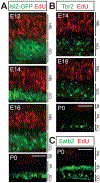Expression of transcription factors divides retinal ganglion cells into distinct classes
- PMID: 28078709
- PMCID: PMC9444162
- DOI: 10.1002/cne.24172
Expression of transcription factors divides retinal ganglion cells into distinct classes
Abstract
Retinal ganglion cells (RGCs) are tasked with transmitting all light information from the eye to the retinal recipient areas of the brain. RGCs can be classified into many different types by morphology, gene expression, axonal projections, and functional responses to different light stimuli. Ultimately, these classification systems should be unified into an all-encompassing taxonomy. Toward that end, we show here that nearly all RGCs express either Islet-2 (Isl2), Tbr2, or a combination of Satb1 and Satb2. We present gene expression data supporting the hypothesis that Satb1 and Satb2 are expressed in ON-OFF direction-selective (DS) RGCs, complementing our previous work demonstrating that RGCs that express Isl2 and Tbr2 are non-DS and non-image-forming, respectively. Expression of these transcription factors emerges at distinct embryonic ages and only in postmitotic cells. Finally, we demonstrate that these transcription factor-defined RGC classes are born throughout RGC genesis.
Keywords: RRID: AB_10615604; RRID: AB_11143446; RRID: AB_1608077; RRID: AB_2167511; RRID: AB_2301417; RRID: AB_2313614; RRID: AB_231491; RRID: AB_882455; cell fate; retinal ganglion cells; transcription factors.
© 2017 Wiley Periodicals, Inc.
Conflict of interest statement
Figures





References
Publication types
MeSH terms
Substances
Grants and funding
LinkOut - more resources
Full Text Sources
Other Literature Sources
Molecular Biology Databases
Miscellaneous

